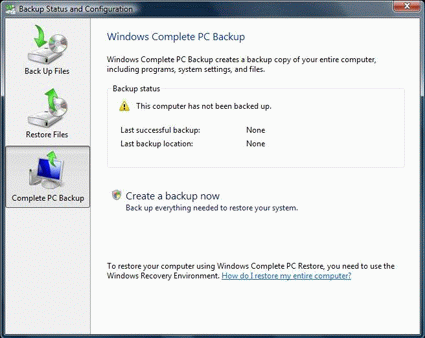6 Bare Metal Backup and Recovery Options
We look at full disk backup and restore packages for Microsoft Small Business Server and Vista desktops to help you decide what's best for your networks and systems.
Workstation-only Options
Windows Vista Backup And Restore Center
To launch this tool, click Start, Control Panel, Backup and Restore Center, then click on the Complete PC Backup icon in the task pane at the left, as shown in Figure 3.

In Control Panel Task view, access image backup using the Complete PC Backup button (in Classic View, it reads "Back up computer").
Next, you must define a target where you’ll deposit your backup image. You can select either a hard disk (which may be a shared network drive, an internal drive, or a locally-attached external USB drive), or a DVD burner. Once this selection is confirmed, the backup process begins.
When running the restore, you’ll be asked to identify the target drive where the image should be written. You have the option of copying all partition and MBR data along with the restore, or omitting that information. You’ll want to do this in most cases when performing a bare-metal restore, though when moving from a smaller to a larger drive - as is so often the case nowadays when drives must be replaced - you might then have to resort to Disk Management to set up a new partition in otherwise unallocated space. Alternately, you can use a tool like Norton Partition Magic or Acronis Partition Manager to increase the partition to encompass all available space on the drive.
We found another technique that also works for bare-metal restore when working with drives of different sizes. We didn’t copy the partition table and MBR data as part of the restore, but elected the basic image restore operation on a system drive. After this first process was complete, we mounted that SATA drive in an already-running Windows XP system (Vista would work just as well) and used Disk Management to mark the primary partition as active. Once that step was completed, we stuck the drive in the old system we were repairing, used the install media to repair that installation, and selected the rebuild MBR and partition table options, after which everything worked just fine.
See Table 2 after the individual product descriptions for comparative timings using all three tools. We think you’ll find some interesting surprises therein.
Sign up to get the BEST of Tom's Guide direct to your inbox.
Get instant access to breaking news, the hottest reviews, great deals and helpful tips.
Current page: Workstation-only Options
Prev Page Which BMBR Product Is Best For You? Next Page Acronis True Image 11.0